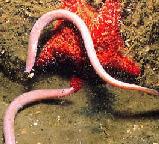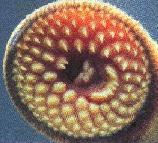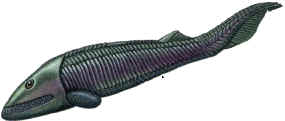Agnatha
Reminder: Clicking on the picture will take you to the site where I originally found it.
Agnatha means "without jaws," and that is the most distinguishing feature of this super-class. These are the jawless fish, and there have been agnatha on the earth since the Cambrian era, about 500 million years ago.
The agnatha all have certain characteristics. Most obviously, they have no jaws. Jaws developed later from the gills. Consequently, there are more gills in agnatha - usually seven or more. Modern agnatha have no bone, but cartilage instead. They lack the same fins which modern fishes have too.
A couple more interesting facts - in hagfishes, an individual has both male and female gonads (ovaries and testes), but only one set works. Lampreys have divided sexes though. Also, both have a pineal eye, sometimes referred to as a third eye. This eye senses light only. In advanced vertebrates, this "eye" is inside the brain.
Hagfish
 Hagfish are about as un-fishlike as you can get and still be a fish. They resemble the lancelets more than salmon or trout.
Hagfish are about as un-fishlike as you can get and still be a fish. They resemble the lancelets more than salmon or trout.
Hagfish, also known as Mixini have no eyes. They have a pineal eye which senses light, but that's it. They have no bones and have nearly the same composition as the salty water around them. The heart of the hagfish only has two chambers.
As stated before, hagfish have both male and female gonads. This seems to be a carried-over trait from its hermaphroditic ancestors. Hagfish are considered very much like the ancestor of all vertebrates.
Hagfish have a somewhat repulsive way to feed. They find a dead or wounded fish and enter its body through any available orifice. They then eat the fish from the inside out. Despite their unusual characteristics and unfair name, the hagfish does have a charm about them.
The last things you should know are that hagfish produce a lot of slime, and they can tie themselves in knots. It is believed that they do both of these things to avoid getting eaten.
Lamprey
 The lamprey look a whole lot like eels. They aren't though. Eels are true fish, and lampreys have no jaws. Make sure you look closely at the mouth. It works like a suction cup.
The lamprey look a whole lot like eels. They aren't though. Eels are true fish, and lampreys have no jaws. Make sure you look closely at the mouth. It works like a suction cup.
With this specialized mouth, lamprey can attach themselves to another animal and get nutrients from them. Because of this, lampreys were responsible for killing a whole lot of fish in the Great Lakes about 50 years ago.
Lamprey go through a long larval stage lasting 5 years. The larvae may hatch in salt or fresh water, but adults prefer salt water. They have developed beyond the hagfish in the ability to regulate the salt in their bodies. They also have eyes and a tongue.
Ostracoderms
 Most agnatha are extinct. They belonged to a group known as ostracoderms. These fish were plated in bone, making them tough. otherwise they came in many different shapes.
Most agnatha are extinct. They belonged to a group known as ostracoderms. These fish were plated in bone, making them tough. otherwise they came in many different shapes.
A drying of the earth and the loss of shallow marine environment led to the extinction of the ostracoderms. They remain important in fossil history, however, as the earlies animals to develop bone, especially backbone.
Back to the Chordate page, or
to the overview.
 Hagfish are about as un-fishlike as you can get and still be a fish. They resemble the lancelets more than salmon or trout.
Hagfish are about as un-fishlike as you can get and still be a fish. They resemble the lancelets more than salmon or trout.  The lamprey look a whole lot like eels. They aren't though. Eels are true fish, and lampreys have no jaws. Make sure you look closely at the mouth. It works like a suction cup.
The lamprey look a whole lot like eels. They aren't though. Eels are true fish, and lampreys have no jaws. Make sure you look closely at the mouth. It works like a suction cup. Most agnatha are extinct. They belonged to a group known as ostracoderms. These fish were plated in bone, making them tough. otherwise they came in many different shapes.
Most agnatha are extinct. They belonged to a group known as ostracoderms. These fish were plated in bone, making them tough. otherwise they came in many different shapes.